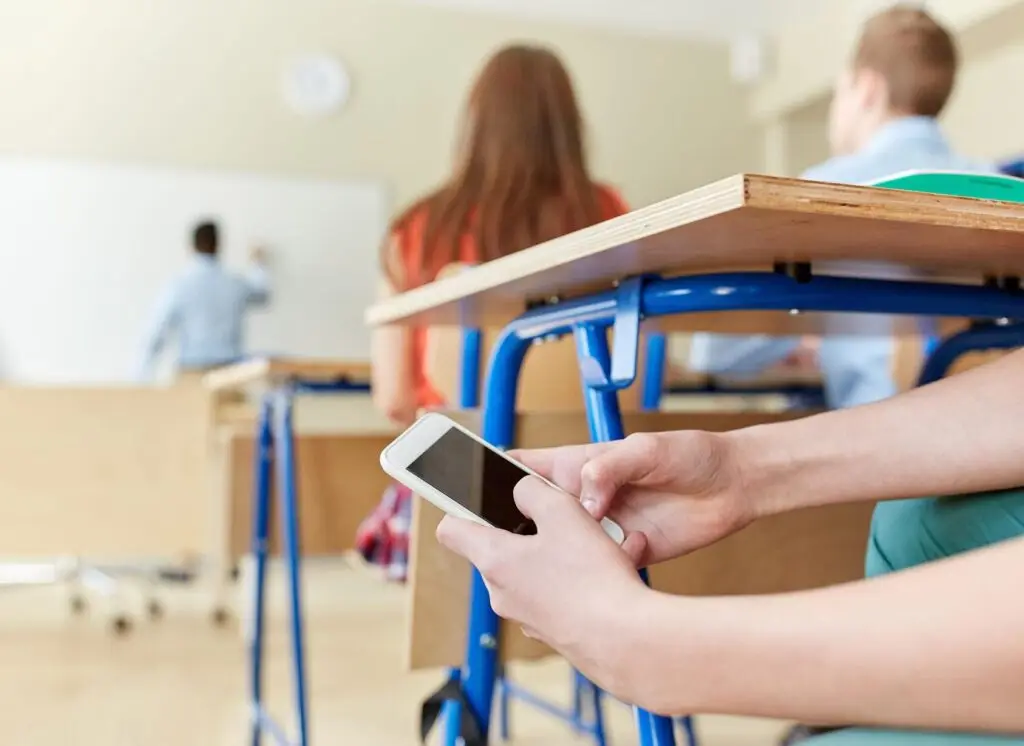In response to new state legislation concerning cellphone usage in schools, the Glendale Unified School District (GUSD) is reviewing its existing policies to determine how best to address student needs. With two state laws set to take effect in the coming years, GUSD and other school districts throughout California are re-evaluating how they manage cellphone use on school campuses.
On September 23, Governor Gavin Newsom signed Assembly Bill (AB) 3216, also known as the Phone-Free School Act. This law mandates that by July 1, 2026, every school district in California must adopt a policy that limits or prohibits the use of smartphones during school hours or under the supervision of school district employees. The policy must be updated every five years, with significant input from stakeholders to ensure it reflects the community’s needs and values.
The law highlights the increasing concerns about how unrestricted cellphone use can interfere with students’ learning, promote cyberbullying, and contribute to rising levels of anxiety, depression, and even suicide among teenagers. However, there are exceptions to the law. Students are still allowed to use their phones in emergencies, when directed by a teacher or administrator, if required by their Individualized Education Program (IEP), or if deemed necessary by a licensed physician.
Governor Newsom also signed Senate Bill (SB) 1283, which gives school districts the authority to limit or prohibit the use of social media by students during school hours.
At GUSD, the recent state legislation prompted discussions about current policies and how best to proceed. While each GUSD school site has its own set of rules, the general policy requires that cellphones be turned off during instructional time unless specific exceptions apply. These exceptions include emergencies, teacher or administrator approval for educational purposes, health-related reasons determined by a physician, or if a student’s IEP mandates the use of a device.
For the district’s elementary schools, cellphones must remain off and stored in backpacks throughout the school day, including during recess and lunch, except in cases where an accommodation permits access. In GUSD middle schools, cellphones must be turned off and put away once students arrive on campus, including during lunch and passing periods. Repeated violations of the cellphone policy can result in consequences such as confiscation or loss of cellphone privileges.
High schools in GUSD allow more flexibility. Teachers at schools like Clark Magnet High School, Crescenta Valley High School, and Glendale High School can set their own classroom policies. The use of cellphone storage systems, such as numbered pockets on the wall, is common practice. Some teachers allow students to use their phones for research, while others maintain stricter rules about keeping devices out of sight. Hoover High School has implemented a pilot program requiring students to place their phones in a pouch during each class. The school also designates “Green Zones,” such as the quad and cafeteria, where students can use their phones during breaks, and “Red Zones,” such as classrooms and locker rooms, where phones must remain off and out of sight.
Feedback from both students and staff regarding Hoover High’s pilot program has been positive, according to school officials. To gather more input on the issue, GUSD conducted a survey that received nearly 5,000 responses from students, parents, and staff. While most parents and guardians were satisfied with the current policies, many teachers expressed concern that the existing regulations were not strict enough. On the other hand, students found the current rules to be overly restrictive. Survey results also indicated a general consensus for stronger cellphone restrictions at lower grade levels, with concerns that inconsistent enforcement, rather than the policy itself, might be the issue.
At a recent board meeting, GUSD board members discussed their thoughts on the matter, expressing a preference for having cellphones silenced rather than completely turned off during the school day, allowing parents to contact their children if necessary. However, they also supported keeping phones put away during instructional time to minimize distractions in the classroom. Board member Neda Farid emphasized the importance of removing distractions in the classroom, noting that teachers already face enough challenges when students are preoccupied with their devices. She suggested that cellphones should be kept in cubbies or other storage areas during class time.
Alice Roh, a teacher in the Beverly Hills School District and a parent of two Crescenta Valley High School students, voiced support for banning cellphone use during instructional time but expressed mixed feelings about restricting use during non-instructional periods. She highlighted that eliminating phone use in class reduces behavioral issues like students taking inappropriate pictures or cheating.
Comparing GUSD’s approach to that of neighboring districts, Burbank Unified School District has a district-wide cellphone policy that restricts cellphone use during instructional hours but allows limited use for educational purposes. La Cañada Unified School District permits elementary students to bring cellphones but requires them to be turned off and put away. At La Cañada High School, cellphones can only be used under teacher supervision. Repeated violations can result in students attending Saturday school and having their phones confiscated.
GUSD Communications Director Kristine Nam noted that while GUSD is awaiting further guidance from the California Department of Education regarding the newly signed laws, the district does not anticipate needing to make significant changes to its current policies. Nam pointed out that GUSD already enforces cellphone restrictions, in line with the intent of the newly signed legislation.
In a previous press release, Governor Newsom had urged California school districts to take proactive steps to limit cellphone use, citing evidence that reduced smartphone usage leads to better academic performance, higher test scores, improved student engagement, and fewer incidents of bullying. Newsom commended districts like Santa Barbara Unified and Bullard High in Fresno for their efforts to reduce cellphone use on campus and encouraged other districts to follow suit.
The recent AB 3216 legislation aims to further support this push, helping students focus on academics and social interactions rather than their screens while at school.







